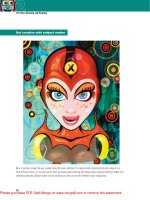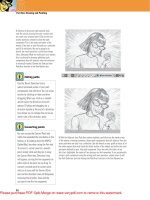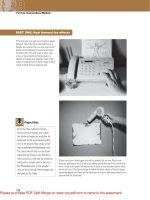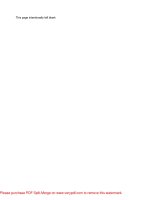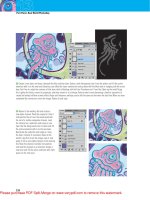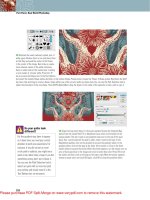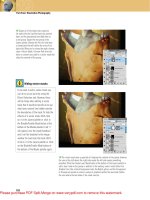Creative Photoshop CS4 Digital Illustration and Art Techniques - phần 2 ppt
Bạn đang xem bản rút gọn của tài liệu. Xem và tải ngay bản đầy đủ của tài liệu tại đây (6.32 MB, 44 trang )
32
Part One: Drawing and Painting
2
18 Use the Path Selection tool to select your
tooth shape component and Alt(PC)/Option(Mac)-
drag it to the right to copy it within the shape
layer. Repeat the process again until there are
three teeth on this layer. Target all three shape
components and then click on the Align Vertical
Centers button in the Tool Options bar to align
the shape components. Use the Pen tool to
create an antenna shape on the left side of the
head, on a new, different colored shape layer.
Ensure the Link button is disabled in the Tool
Options bar, and set the style back to none in the
style picker.
Build half of the face
Put your new shape layer skills to good use as you create all of the details for the left side of the face on a series of shape layers.
1 Use the methods employed
so far to create a new, red,
elliptical shape layer. Choose
EditϾ Free Ͼ Transform Path from
the menu. Drag the corner points to
resize, then click and drag outside
of the box to rotate. Press Enter to
apply the transformation.
2 Use this method to create a smaller,
orange ellipse shape layer on top of the
red one. Then repeat the process again,
creating a smaller, black ellipse shape
layer. Create a white ellipse shape layer
over top of the black ellipse and reduce
the layer opacity.
3 Use the Pen tool, the Ellipse tool,
and the skills you’ve learned so far to
create the rest of his face details on a
series of new shape layers until the left
side of his face is complete. Target all
of these layers, including the antenna
layer, and add them to a new group.
33
2
Chapter 2: Creating Characters with Shape Layers
19 Ensure that your group is targeted in the
Layers palette and select the Move tool.
Hold
down the Alt(PC)/Option(Mac) and Shift keys as
you click on the canvas and drag to the right,
duplicating the group and ensuring that it stays
aligned vertically with the previous group. Then
choose Edit Ͼ Transform Ͼ Flip Horizontal from
the menu to flip the group. Use the Move tool
or the arrow keys on the keyboard to adjust the
positioning on the canvas if necessary. Target
all of the layers and groups that make up the
alien character in the Layers palette and add
them to a new group.
PART THREE: The third character
20 Now that you’ve created two distinctly different characters out of shape layers,
storing each in a group of its own, create one more for the sake of diversity. Use
the Pen tool to click and drag, creating a closed object that resembles tentacles
on a new shape layer. Specify a green fill color and then switch to the Ellipse tool.
Ensure that the Add to Shape Area function is enabled in the Tool Options bar. Click
and drag to create a large ellipse that overlaps the top of the tentacles shape on
the same layer, creating a strange octopus body.
Transforming and flipping
artwork
You don’t always have to go to the Edit
menu each time you wish to perform
a transformation or flip a layer, shape
component, or group. Simply type
Control/Command-t to activate the
Free-Transform command. You’ll see the
bounding box appear, allowing you to
transform your object, layer, or group.
While the bounding box is present,
right-click(PC)/Control-click(Mac)
within the box to access a pop-up menu.
Alongside other options, you’ll be able
to flip your artwork by choosing the
appropriate option from the menu. As
always, pressing Enter will apply the
transformation.
34
Part One: Drawing and Painting
2
21 Again, as you’ve done with the previous two characters, create
a series of new shape layers to add the character’s essential
features and details to the file. All of the methods are the same
as before. Even the mouth, although it has more teeth, can be
created by using the same methods that you used to create the
blue creature’s mouth earlier on. When you’re finished, target
all of the shape layers that make up the octopus in the Layers
palette and add them to a new group.
Examine the downloaded
files
At this point in the chapter, you should
have the three main characters
completed and organized into groups.
Everything you need to know to
effectively create the characters has
been outlined on the previous pages.
However, if you still find yourself
confused by a small detail or are
scratching your head over something,
have a look at the sample files included
in the archive you downloaded. The files
are named sample-1.psd, sample-
2.psd, and sample-3.psd. Each file
contains a single character group and
you can inspect the shape layers and
components in detail within these files.
22 Now, just because your finished
creatures are neatly organized into groups
in the Layers palette, it doesn’t mean that
you can’t add more shape layers within
a group or edit existing ones. Here, new
shape layers were added to the octopus
group as well as the alien group. Spots
were added to the tentacles of the octopus
on a new shape layer and to the alien’s
forehead using the same method. Each new
layer was placed in the appropriate group,
ensuring that the Layers palette remained
organized.
35
2
Chapter 2: Creating Characters with Shape Layers
PART FOUR: Duplicates and variations
23 Duplicate the octopus group. Use Free-
Transform to rotate, resize, and move it to
another location on the canvas. Double-click
individual layers within the group and change
their fill colors. Delete the shape layers that
make up his mouth by dragging them into the
trash in the Layers palette. Then add a new
shape layer that contains a small black ellipse
to the group, creating a new mouth with a
different facial expression. Use this method to
create a number of different octopus groups
on the canvas. Alter colors and shape layers as
you see fit.
24 Continue to make duplicates of your groups, moving them to different areas of
the canvas, and using Free-Transform to rotate and resize your groups. Move them
up and down within the Layers palette so that some characters are overlapping
others. Try varying blending modes of your duplicate groups here and there. Also
experiment with reduced opacity to make some of them less prominent.
36
Part One: Drawing and Painting
2
25 Duplicate the blue creature group. Move it to another location and use
Free-Transform to resize and rotate the group. Repeat this process over and
over, adding a number of blue creatures to the scene. Inside some of your
groups, disable the visibility of some of the layers or delete them so that
only select portions of the characters ’ faces remain visible. Like you did
previously with the octopus, move duplicate groups up and down within the
Layers palette altering the blending modes and opacity settings of entire
groups as you go.
Hiding versus deleting
When you are creating duplicate
character groups and wish to remove
layers from the group, disable them
rather than delete them. You can disable
the visibility of any layers you wish to
hide, and when you transform an entire
group, these hidden layers will be
transformed alongside the rest. This is
a better option than deleting as it gives
you the option of making the layers
visible again if you change your mind
later on.
26 Use these methods to introduce a variety of
copied alien groups into the image as well. Alter
blending modes, opacity, and try disabling the
visibility of some layers. Try combining some of
your duplicates into groups as well. Here, this
creature was created by adding a blue creature
group and an octopus group into a new group.
The blue creature was positioned on top of the
octopus and the fill color of the octopus layer was
changed to match that of the blue creature. Then,
the blending mode of the new group was changed
to luminosity.
37
2
Chapter 2: Creating Characters with Shape Layers
27 Now that you’re finished with the character groups, apply the same methods
you’ve used so far to create some shape la
yers out of basic shape combinations.
Use the Subtract and Add to Shape Area options freely. Also, have some fun with
different blending modes, color fills, and layer opacity settings. Drag all of the new
shape layers beneath the character groups in the Layers palette, so that the new
shape layers are used to enhance the painted background rather than overlapping
the creatures. Place the new shape layers in a group of their own, just to keep the
Layers palette organized.
Examining your shape layer masterpiece
Now that you’re finished creating the image, let’s take a final look at some of the exceptional features and techniques invol v e d .
a
By duplicating a group of features, you’re not only
cutting your work in half, but you are effectively creating
an identical set of features for the other side of the face.
b One great thing about shape layers is that you can
change the fill color at any point, so duplicate groups
can look diverse rather than monotonous.
c Replacing something as simple as the shape layers
that make up the mouth in a duplicate group can
completely change the emotion of your character.
d When you’re spreading duplicate groups around the
canvas, disabling the visibility of base layers within a
group can result in ghostly, floating creatures rather than
identical duplicates.
e Experimenting with blending modes allows you to use
your characters in subtle ways. In this case, the creature
enhances the background using only its luminosity.
e
a
b
d
c
38
Part One: Drawing and Painting
2
Get creative with subject matter
Here is another image that was created using the same methods. It is quite similar stylistically, but the subject is a
little different. There is a lot you can do when you begin experimenting with shape layers, groups, blending modes, and
underlying textures. Subject matter can be anything you like; you’re only limited by your imagination.
39
2
Chapter 2: Creating Characters with Shape Layers
Try to deviate from basic shapes
In order to create truly unique characters, you’ll need to get away from basic preset shapes and master the process of
drawing with the Pen tool. It takes a bit of practice, but as you can see here, the results are worth it. It may take a while
before you’re creating detailed slugs like the creature shown here, but mastering the Pen tool will help you achieve other
tasks in Photoshop with ease. Path drawing skills also prove valuable outside of Photoshop and are of great assistance
when you’re working within a vector art program like Adobe Illustrator.
Paint Art
T
o create realistic graffiti art, you no longer have to hit the streets with a
backpack full of spray cans, looking for that secluded area where you won’t
get caught. You don’t need to place yourself at the mercy of the elements, and
you don’t need to break the law. All that you need these days is a digital photo,
a scanned drawing of your plan, and a little Photoshop kno
w-how.
Photoshop offers all of the tools necessary to add innovative digital graffiti to any
photographed scene. Brushes, selections, and layer blending modes are essential Photoshop
tools to get the job done. In this chapter, the standout features are the Brush tool’s Airbrush
option and flow settings. Above all other features, these are key ingredients in producing
convincing graffiti art. These two features gi
ve the Brush tool it
s authentic spray paint feel
and allow you to produce convincing spray paint results.
However, in order to make things feel real, you’ll also need to incorporate some real-
world imperfections. While producing real spray paint art, you get annoying drips littering
your masterpiece when you apply too much paint to a single area at once. And although
this imperfection is something you’d try to a
void in the real w
orld, here, in the digital
realm, this imperfection is required to lend authenticity to your art.
For the authentic spray paint look, you’ll need to incorporate the real thing. In this
particular case, I’ve incorporated some basic paint drips, done traditionally, into the digital
composition, gi
ving it an authentic
feel. And rather than creating a digital backdrop for
the graffiti art, it is painted directly on top of a photo of a bare wall, using layer blending
modes to make it look as if it really belongs there. So remember, when creating realistic
graffiti in Photoshop, it is not just paint techniques that you’ll need to employ but
innovative image composition methods as well.
Chapter 3
A basic understanding of the Brush tool and Layers palette will make
this chapter easier for you. Experience in painting with a mouse will
be your greatest asset here, as the most diffi cult part will be actually
producing the strokes that you intend to make. It takes practice. If you’re
a pressure-sensitive tablet user, the process will be less cumbersome, as
painting with a mouse can feel unintuitive at times.
42
Part One: Drawing and Painting
3
What you’ll learn in this chapter
Creative Techniques and Working Methods
Combining digital with tactile
Something as small as the inclusion of actual paint drips can have an immense effect on how
authentic the work seems at the end of it all. It is very important to exercise a little forethought
when you set out to do something like this. Knowing that I was going to be spraying paint
digitally, and knowing that I could get that paint to build up naturally, I knew that I wanted it to
drip. Now, there is no gravity in Photoshop, so creating dripping paint would have to be done in
the real world or carefully faked digitally. Although this is a common theme that pops up again
and again throughout this book, it is very important to mentally prepare yourself for the task at
hand.
Pre-Photoshop preparation
Simply put, think about what you’re going to do ahead of time. Get everything together and then
launch Photoshop. As you work your way through this chapter and get to the dripping paint part,
it will become clear that spraying these drips on paper ahead of time was the best and most
efficient method to create a realistic effect. You’ll develop an understanding of the importance
of preparation as well as how very small details can be the deciding factor in whether or not
your artwork appears genuine.
Photoshop Tools, Features, and Functions
Airbrush capabilities
This feature does not get enabled often. But for this chapter, we wouldn’t be able to live without it. It allows the
brush to deposit paint the way a spray can would. There is an endless stream when you hold the button down and
the movement of the mouse directly affects how much paint is deposited in a given area.
Opacity and flow
Using these two Brush tool options together allows you to customize how paint is
deposited by your virtual airbrush. The numbers you enter in these fields will have an
immense effect on how natural your sprayed strokes appear.
43
Chapter 3: Graffi ti Spray Paint Art
3
PART ONE: Preparing the wall
1 Open up the wall.jpg file. This will act as your background for the image and this
file will become the bottom layer of our multilayered working file. The first thing
you notice about the wall is that the darker details are not pronounced enough.
Perhaps the original photograph was a little overexposed. To remedy this, drag the
background layer onto the Create a New Layer button at the bottom of the Layers
palette to duplicate it. Target the duplicate layer and change the blending mode
of the layer to linear burn. Reduce the opacity of the layer to 67% so that the burn
effect isn’t overpowering.
2 In order to make the painting stand out even more, let’s reduce the amount of
color in this already very neutral-feeling background. Click on the Create New
Fill or Adjustment Layer button at the bottom of the Layers palette to access the
pop-up menu of Adjustment and Fill Layer options. Choose Hue/Saturation from the
list to create a new hue/saturation adjustment layer. Another method for creating
a hue/saturation adjustment layer is to click on the Hue/Saturation button in the
Adjustments panel. The method you choose to create the hue/saturation adjustment
layer doesn’t matter. In either case, reduce the saturation by around 28 in the
Adjustments panel to remove color from the underlying layers. Click OK.
All of the files needed to follow
along with this chapter and create
the featured image are available for
download on the accompanying Web
site in the project files section. Visit
www.creativephotoshopthebook.com .
Project files
44
Part One: Drawing and Painting
3
PART TWO: Black outlines
3 Open up the drawing.jpg file. Choose Image Ͼ Adjustments Ͼ Invert from the
menu to convert the artwork to a negative. Type Control(PC)/Command(Mac)-a to
select all and then type Control(PC)/Command(Mac)-c to copy the selected image.
Return to your working file and navigate to the Channels palette. In the Channels
palette, click on the Create New Channel button at the bottom of the Channels
palette to create an empty alpha channel. Target your new alpha channel and type
Control(PC)/Command(Mac)-v to paste the copied art into your new channel.
4 Ensure that the new channel remains targeted and then click on the Load
Channel as Selection button at the bottom of the Channels palette. Return to the
Layers palette and click on the Create a New Layer button to create a layer at the
top of the stack within the palette. Press the “ d ” key to set your foreground color to
black. Then, ensure that your new layer is targeted and type Alt(PC)/Option(Mac)-
Delete on the keyboard to fill the current selection with black on the new layer. Type
Control(PC)/Command(Mac)-d to deactivate the selection.
The black-and-white art here is a
very sharp and finely tuned piece of
artwork. However, what makes every
graffiti artist unique is his or her style
of drawing. Feel free to carefully draw
your own black-and-white artwork
and substitute it for the one used
here. There is no part of the process
more appropriate to expressing your
individual style than the black-and-
white art stage. You can create any
subject you like, but try to make it a
nice, sharp piece in solid black and
solid white. This will help to keep the
channel clean, resulting in a nice,
clearly defined selection border.
Go your own way
45
Chapter 3: Graffi ti Spray Paint Art
3
5 Use the Move tool to position the layer contents a little higher on the canvas.
Change the layer blending mode to multiply and then reduce the opacity of the
layer to 75%, providing a hint of transparency. With your black outline layer
targeted, choose Filter Ͼ Blur Ͼ Gaussian Blur from the menu. Enter a radius setting
that softens the edges of your black line work. Softening the edges, combined
with the layer blending mode of multiply, is what will give the art on this layer the
appearance of being sprayed onto the wall. Be careful not to soften the edges too
much, you still want your artwork to look like something.
PART THREE: Paint drips and buildup
6 Now, as mentioned in the introduction,
sometimes you need to resort to the real thing
to achieve authenticity in your digital art. Here,
a series of black paint drips were painted on
a white piece of paper. Holding the can in one
place while spraying allows you to build up
enough paint in that spot so that it begins to run.
Black and white were used because these paint
drips, after being scanned, are destined to be
used to create custom selections within a series
of alpha channels .
Because you are pasting black art
on a white background into an alpha
channel, it needs to be inverted
first, so that the art is white and
the background is black. A quick
way of inverting your art is to type
Control(PC)/Command(Mac)-I on the
keyboard. Or, you can leave your art in
its positive state and double-click your
alpha channel in the Channels palette.
Then, from within the Channel options,
change things so that color indicates
selected areas rather than masked
areas before you paste your copied art
into it.
Inverting images
46
Part One: Drawing and Painting
3
7 Go ahead and paint your own drips if you like. If you’re doing it on your own, be certain that the paint is completely dry before you
scan it. Spray paint is difficult to remove from any surface — that’s what makes it so appealing for outdoor art. If you’d rather focus on
Photoshop instead of making a mess, the dirty work here has already been done for you. Open up the drips.jpg file. This is a desktop
scan of a group of spray paint drips. Invert the file and then use the Lasso tool to draw a rough selection that contains one entire drip.
Adding a paint drip
Paste a copied paint drip into your alpha channel using the visible composite channel to aid with proper positioning.
1 Copy the selected drip and
return to your working file. Create
a new channel, ensuring that color
indicates masked areas (the default
setting). Target your new channel
and enable the visibility of your
CMYK composite channel in the
Channels palette.
2 Now that you have your new
channel targeted and your
composite channel visible, paste the
copied art into your new channel.
Choose Edit Ͼ Free-Transform from
the menu. Shift-drag a corner of the
bounding box inward to reduce the
selection contents.
3 Click and drag outside of the
bounding box to rotate the contents
as necessary. Click and drag within
the bounding box to position your
drip over a corner area of your
black outline art. Press Enter to
apply the transformation.
47
Chapter 3: Graffi ti Spray Paint Art
3
8 Use this method to copy selected drips from the drips.jpg file and paste them
into your alpha channel. Keep the visibility of the composite channel enabled
to help you position your drips properly and use Free-Transform to adjust size,
rotation, and placement. When you have a number of drips in your channel that sit
nicely over appropriate areas of the image, load the channel as a selection.
9 After generating the selection, click on the CMYK composite channel at the top
of the Channels palette to target it. Next, click on the eye icon to the left of your
alpha channel to disable the visibility of that channel, causing the red overlay
to disappear. Return to the Layers palette and ensure that the layer containing
your black outline art is targeted. Fill the current selection with black on this
layer and deselect. If you haven’t changed your foreground color, it should still
be set to black. In this case, all that you need to do to fill the selection is to type
Alt(PC)/Option(Mac)-Delete. Then type Control(PC)/Command(Mac)-d to deactivate
the selection.
When placing a drip area within the
image, try to think of where it would
occur realistically.You know that drips
traditionally occur because too much
paint is applied in a single area at one
time. So try to look at areas of the art
where a spray can is likely to spend a
lot of time. Corners are a perfect place.
Actually, anywhere where two lines meet
means that the spray can will deposit
more paint in that area. Working along
these lines will aid in achieving a
realistic result. However, don’t let the
rules of the real world deter you from
adding a drip where you think it will
look good. Although we’re using the
laws of nature as our guide here , they
certainly don’t bind us.
Placing drips
48
Part One: Drawing and Painting
3
10 Select the Brush tool. In the Brushes palette, choose one of the soft, round
brush tip presets. Disable shape dynamics because we do not want the actual
thickness of the stroke to change. Enable the Airbrush option as well as the
Smoothing option. Leave the brush opacity set to 100% but reduce the flow to 30%
in the Tool Options bar. Try painting a few strokes at various areas on the black
layer that surround the outline art. The longer you stay in one place with the mouse
button down, the more the paint will build up in that area.
11 Reducing the flow forces the brush to behave like true spray paint because
paint is deposited in your stroke at a slower rate. Mo
ve the mouse quickly while
holding down the button to paint a light stroke or move slowly to paint a darker
stroke. The faster you move the mouse, the less paint will be deposited in the stroke
because the flow cannot keep up with you — just like real-world spray painting.
Try creating a stroke very quickly while holding down the mouse button. Then stay
completely still at the end of the stroke while continuing to hold down the mouse
button. This will cause paint to build up in the area where you are hovering — just
like it would if you were using a real spray can.
When you’ve hit upon a combination of
brush settings you like, you can save
the brush in the current state as a
preset, to access it again directly at any
point later on. Just open the Tool Preset
picker at the far left of the Tool Options
bar. Once the picker is open, just click
on the Create New Tool Preset button
to add your current tool to the list of
presets. From that point on, your brush
will reside within the preset picker for
immediate access.
Saving your tool preset
49
Chapter 3: Graffi ti Spray Paint Art
3
12 Use this method to add some primarily lighter strokes around the edges and
over top of the black outlines, giving it an authentic look. Also try increasing the
brush size and reducing the flow so that it looks as if the spray can was held
further away while you were painting on the wall. Continue painting on this layer
until you think the black spray paint effect is complete. Also, if you feel that you
need some more drips on this layer, use the methods employed previously to add
drips. Create a new layer and drag it beneath the black outline layer in the Layers
palette.
PART FOUR: Color and highlights
Adding color
1 Click on the Foreground Color
swatch in the toolbox and choose a
pink color from the picker. Reduce
your brush diameter slightly in the
Brushes palette. Begin to paint some
strokes within areas defined by black
outlines on the new layer.
3 Use this method to add a variety
of colors into the shape areas on the
current layer, defined by the black
outline layer. Remember to vary flow
settings, brush diameter, and the
speed at which you paint your strokes
to achieve the authentic spray paint
effect.
2 Paint like you did previously,
using a v
ery low flow setting and
numerous strokes of varying speed
and thickness. Now select a purple
color from the picker and continue to
paint some purple strokes within the
same regions of the artwork on the
current layer.
50
Part One: Drawing and Painting
3
13 Create a new layer and drag it to the top of the Layers palette. With the new
layer targeted, and the Brush tool still selected, press “ d ” on the keyboard to
reset the foreground and background colors to their default settings of black and
white. Then type “ x ” to reverse them. Reduce the master diameter of your brush
tip considerably in the Brushes palette and if you’ve reduced the flow setting,
increase it to 30% once again. Use the current brush settings to paint a series of
white strokes on this new layer to create highlights on the shapes inside the black
outlines.
14 Continue painting until there are deposits of solid white here and there. Also,
incr
ease the diameter of the brush and reduce the flow. Then paint some strokes
with these brush settings to create a softer, more gradual highlight effect within
the shapes. When you’re finished painting, return once again to your inverted drips.
jpg file. Use the Lasso to draw a rough selection around a cluster of drips and
copy it. Return to the working file, create another alpha channel, and target it in the
Channels palette. Enable visibility of the composite channel again and then paste
into your new alpha channel.
Rather than always returning to the Tool
Options bar to adjust opacity and flow
settings when using the Brush tool, a
couple of useful keyboard shortcuts
will improve your efficiency while
working. Quickly pressing a number
key on the keyboard will set your brush
opacity, using a multiple of ten. Or, if
you want something precision, simply
type the two numbers of your desired
opacity. Holding down Shift while
pressing a number key will allow you to
adjust the flow instead of the opacity. If
you have the Airbrush option enabled,
things are reversed. When the Airbrush
is enabled, simply pressing a number
key changes the flow and holding down
the Shift key while you press a number
key changes the opacity.
Opacity and flow
51
Chapter 3: Graffi ti Spray Paint Art
3
Unlike traditional painting, we can
change our minds regarding color
after the fact when creating graffiti
art in Photoshop. Because different
colors exist on different layers you can
target any individual layer and alter the
color via Image Ͼ Adjustments Ͼ Hue/
Saturation. Also, you can target a
layer in the Layers palette, enable
the transparency lock, and then fill
the targeted layer with any color you
choose. This will allow you to instantly
change the painted areas of the layer
while preserving the transparent areas.
Varying paint colors
15 As before, use Free-Transform to rotate,
resize, and position the drip. Position it so that
it overlaps an area of opaque white and then
press Return to apply the transformation. Repeat
this process to add a few drips to the alpha
channel and then generate a selection from it.
Target the composite channel and disable the
visibility of your new alpha channel. With the
current selection active, return to the Layers
palette. Target the layer with the white highlights
painted onto it. Specify a white foreground color
and fill the active selection with it. Deactivate
the selection.
16 Create a new layer and drag it beneath the white highlight layer in the Layers
palette. Greatly reduce the size of your brush so the stroke thickness is similar to
that of your thin white highlight strokes. Set the flow to 35% and begin to paint
some red highlights outside the black outline on the new layer. Be certain to paint
over some areas enough times so that there are a few solid red blobs of paint on
this layer. Also, increase the brush diameter and reduce the flow setting. With these
brush settings, paint some larger, softer strokes here and there on the current layer.
52
Part One: Drawing and Painting
3
17 And now for what is becoming a familiar operation, again, return to the drips image file. Paste some selected drips into a new alpha
channel. Generate a selection from the channel and fill the selected areas with the same red foreground color on the current layer.
Deactivate the selection. Feel free at this point to embellish the image by painting some finer strokes of vibrant color on top of the
existing layers on a new layer. Use the now familiar methods you’ve employed all along to finesse your graffiti art.
Dissecting your graffiti art
Let’s recap which methods and techniques are vital when it comes to creating convincing acts of virtual vandalism.
c
a
d
b
a Working with the flow setting allowed us to create
brush strokes with a paint density that reacted to
the speed of the mouse movement. Moving quickly
deposited less paint, allowing us to see the detail of
the wall through the paint in a number of areas.
b Although we imported a perfectly sharp black-and-
white drawing as our outline art, a simple application
of the Gaussian Blur filter produced a soft, convincing
spray paint effect here.
c By incorporating paint drips via channel-based
selections, we were able to force gravity to take
its toll on the artwork, adding to the feeling of
authenticity. Even while using the Airbrush option, no
matter how long you hold the mouse button down in
Photoshop, the paint simply will not drip as it piles up.
d By moving the brush quickly and then holding it in one place with the mouse button pressed, you can simulate what really
happens when you do this with a can of actual spray paint. It is light where the motion was quick and hea
vy where the tool was
stagnant.
53
Chapter 3: Graffi ti Spray Paint Art
3
This graffiti is portable
You can now take what you’ve created here and apply it to any background. First target only the
layers that make up the painted graffiti in the image. Group them and then simply drag the group
into another image window. After you’ve dragged the paint group into an appropriate scene,
simply use Free-Transform to adjust the size and position until it looks authentic.
55
4
55
Creating Stencil Art
S
tencil graffiti is a form of urban art that offers quick and easy reproduction.
Traditionally, a stencil is made from paper, cardboard, or plastic. Usually the stencil
is held tight against a wall or another surface and paint is sprayed onto it. Removing
the stencil after painting reveals an instant application of the stencil art on the
desired surface. Ideally, the paint will only touch the surf
ace in areas
where holes are present in
the stencil. However, part of the signature appearance of stencil graffiti is the overspray effect
that occurs around the edges.
In this chapter, we’re going to create a virtual stencil from an existing work of black-and-white
art. The ideal way to do this is to edit the art and then define it as a Custom Brush preset. However,
rather than painting with the New Brush preset, as we did in Chapter 1, we’ll be using it as a
stamp. All that you need to do to add a virtual stencil to an existing scene is choose the Custom
preset and click once. Photoshop’s custom brush capabilities allo
w you to put a virtual graf
fiti
stamp on any digitally photographed scene with a single mouse click.
Chapter 4
This chapter involves simple use of the Brushes palette. Angle and
diameter are about as complicated as it gets. Aside from working with
brushes, you’ll do some very basic work with selections, layers, masks,
and blending modes.
56
Part One: Drawing and Painting
4
What you’ll learn in this chapter
Size, color, and position
In addition to authentic-looking brushes, placement and position of the stencil itself
is crucial. You really need to think about your underlying image. You’ll need to decide
which color to use and where to put the stencil in the image. With a little practice,
you’ll develop an understanding for what looks real and what doesn’t. Simple analysis
will aid you in determining rotation via brush angle and the size relationship of your
stencil against the background.
Distressing the brush
What makes your stencil art effect convincing is what you do to your artwork before
you define it as a brush. In this chapter, you’ll learn to distress the brush art, as
if it were scratched and affected by the elements. Your overspray needs to look
convincing, and for both realistic distress and convincing overspray, you’ll learn
to incorporate desktop scans of the real thing. Applying stencil art in Photoshop
is indeed as simple as a single click of the mouse, but ensuring that it looks
realistic is the direct result of the care you take in preparing your custom brush
artwork.
Creative Techniques and Working Methods
Custom brush tips
You’ll master the process of creating a customized brush tip. Bearing in mind that black areas deposit
paint and white areas do not, you’ll learn to create distressed and authentic tips that are ideal for
stencil effects. You’ll also gain an understanding of what size to work at while creating your custom
brush.
Lighten
When building up a distressed effect on your brush, you’ll learn the value of the
lighten blending mode as you place the artwork on top of a black brush tip. Do this
by choosing textural images that express distress in white areas against black, and
combining those images with this blending mode .
Photoshop Tools, Features, and Functions
